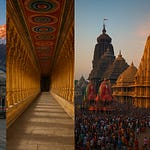Ayodhya, known as Ram Janmabhoomi or Ram ki Nagri, is not just a city—it is the eternal abode of divinity, devotion, and dharma. Situated in the Faizabad district of Uttar Pradesh, along the serene banks of the Sarayu River, Ayodhya is one of the oldest continuously inhabited cities in the world and holds immense historical, mythological, and spiritual significance.
1. Origin and History of Ayodhya
The name "Ayodhya" means "invincible" in Sanskrit. It is said to have been founded by Manu, the progenitor of mankind, and is described extensively in ancient Hindu scriptures:
Mentioned in Atharva Veda as a prosperous and sacred city.
Ramayana by Valmiki identifies it as the capital of Kosala kingdom, ruled by the Ikshvaku dynasty.
Vishnu Purana and Skanda Purana glorify it as one of the seven holiest cities (Sapta Puri).
Timeline of Major Events:
Treta Yuga (~900,000 years ago as per belief): Birth of Lord Ram.
5th Century BCE: Known as Saketa; visited by Chinese traveler Faxian.
7th Century CE: Described by Xuanzang as a Buddhist center.
1528 CE: Babri Masjid constructed.
1853-1949: Religious disputes begin.
1992: Babri Masjid demolished.
2019: Supreme Court verdict in favor of Ram Mandir.
2020: Bhoomi Pujan by PM Narendra Modi.
22nd Jan 2024: Ram Lalla Pran Pratishtha and temple inauguration.
2. Religious and Cultural Importance
Ayodhya is believed to be one of the seven most sacred cities (Sapta Puris) in Hinduism. It finds mention in several ancient texts, including the Ramayana, Atharva Veda, Skanda Purana, and Vishnu Purana. According to Valmiki's Ramayana, Ayodhya was the capital of the Ikshvaku dynasty, ruled by King Dasharatha, the father of Lord Ram.
Ram, the seventh avatar of Lord Vishnu, was born here, making Ayodhya a divine epicenter for Hindus around the world. The name ‘Ayodhya’ means “invincible” or “the place which cannot be conquered.”
Ayodhya is considered the birthplace of Lord Ram, the seventh incarnation of Lord Vishnu and the embodiment of righteousness (Maryada Purushottam). Every inch of this land is believed to be sanctified by Ramayana-era events:
Ram Janmabhoomi: Sacred site where Ram was born.
Sita Rasoi: Kitchen used by Sita, located near Ram Janmabhoomi.
Kanak Bhawan: Gifted to Sita by Queen Kaikeyi.
Hanuman Garhi: A temple dedicated to Lord Hanuman, protector of Ayodhya.
Guptar Ghat: Believed to be the spot where Lord Ram took Jal Samadhi (final departure).
Ayodhya is also a part of the 84 Kosi Parikrama, a major pilgrimage involving circumambulation of Ayodhya over a vast radius.
3. Shri Ram Janmabhoomi Mandir
Ram Janmabhoomi – The Birthplace of Lord Ram
The most sacred site in Ayodhya is the Ram Janmabhoomi, believed to be the exact place where Lord Ram was born. For centuries, it has remained a center of devotion, pilgrimage, and unfortunately, historical dispute. However, in 2020, the Supreme Court of India passed a landmark judgment allowing the construction of the Shri Ram Janmabhoomi Mandir.
On 22nd January 2024, Pran Pratishtha (consecration) of Ram Lalla was conducted, witnessed by millions across the globe, symbolizing a new era of spiritual resurgence in India.
Architectural Style: Nagara style with carved pink sandstone.
Area: Core temple area - 2.7 acres; temple complex - 70+ acres.
Dimensions: 360 feet long, 235 feet wide, and 161 feet high.
Pillars: 392 intricately carved pillars.
Features: Sanctum houses Ram Lalla idol; includes mandaps (Kudu, Nritya, Rang), and Ramayana galleries.
Trust: Shri Ram Janmabhoomi Teerth Kshetra oversees construction and rituals.
Shri Ram Mandir – An Architectural Marvel
The new Ram Mandir is not just a temple—it is a symbol of India’s spiritual unity, cultural pride, and civilizational strength.
Architecture: Built in Nagara style, with intricate carvings and sandstone construction, the temple blends ancient techniques with modern durability.
Size: The temple spans 2.7 acres, with a total temple complex of 70 acres, featuring mandaps, sanctums, and gardens.
Highlights: The temple includes idols of Lord Ram in child form (Ram Lalla), depictions from Ramayana, and halls showcasing the life of Shri Ram.
It stands as one of the grandest temples in the world, drawing inspiration from Vastu Shastra and traditional Hindu temple design.
4. Puja, Aarti & Temple Timings
Temple Opens: 6:00 AM
Mangala Aarti: 6:30 AM
Shringaar Aarti: 7:30 AM
Bhog Aarti: 12:00 PM
Sandhya Aarti: 6:00 PM
Shayan Aarti: 8:00 PM
Temple Closes: 9:00 PM
Note: Devotees can book online aarti passes and participate in special pooja services, yajnas, and bhajan sessions.
5. Major Festivals in Ayodhya
Ram Navami: Grand celebration of Lord Ram's birth.
Deepotsav (Diwali): Celebrated with over 21 lakh diyas lighting the ghats and streets.
Vijayadashami (Dussehra): Ramlila performances followed by effigy burning.
Makar Sankranti, Holi, Kartik Purnima, Shravan Mela are celebrated with spiritual fervor.
Ayodhya is more than just the Ram Mandir. It's a hub of devotion, celebration, and spiritual practices:
Festivals:
Ram Navami – Celebrated as the birth of Lord Ram with grand processions.
Diwali – Marked by Deepotsav, where millions of diyas light up the city, recreating Ram’s return from exile.
Vijayadashami, Makar Sankranti, and Kartik Purnima are also celebrated with great fervor.
Temples to Visit:
Kanak Bhavan – Believed to be gifted to Sita by Kaikeyi.
Hanuman Garhi – A fortress temple dedicated to Lord Hanuman.
Nageshwarnath Temple – Built by Kush, son of Ram.
Treta Ke Thakur – Said to be the spot where Ram performed Ashwamedha Yagna.
Sadhus and Ashrams: The spiritual ecosystem includes various mathas, akharas, and ashrams that preserve Vedic teachings, Ramayana kathas, and devotional music.
6. Tirtha Kshetras (Pilgrimage Spots)
Nageshwarnath Temple: Built by Kush, Lord Ram’s son.
Mani Parbat & Sugriv Parbat: Ancient mounds linked to Ramayana events.
Vashistha Kund: Sage Vashistha’s meditation site.
Ramkot: Fortified area considered the original site of Ram Janmabhoomi.
Bharat Kund: Place where Bharat ruled in Ram's absence.
7. Travel Guide to Ayodhya
By Air:
Maharishi Valmiki International Airport, Ayodhya (AYJ): Operational since 2023.
Connected to Delhi, Mumbai, Varanasi, Lucknow, and more.
By Train:
Ayodhya Dham Junction (AY) and Faizabad Junction (FD)
Well connected to all major Indian cities.
By Road:
National and state highways connect Ayodhya to Lucknow (130 km), Varanasi (200 km), Prayagraj, and Gorakhpur.
Local Transport:
E-rickshaws, taxis, guided tours, and public buses are easily available.
Best Time to Visit:
October to March (Pleasant weather and major festivals)
8. Accommodation and Facilities
Dharamshalas and Ashrams: Budget spiritual stays.
Hotels & Resorts: 3-star to 5-star properties now available.
Temple Trust Guest Houses: Available for pilgrims at subsidized rates.
Digital Facilities: Online bookings, e-aarti, virtual darshan, and guided tours.
9. Global & Civilizational Impact
Ramayan is revered in Indonesia (Ramayana Ballet), Thailand (Ramakien), Nepal, Cambodia, Sri Lanka, and beyond.
Ayodhya is emerging as a global spiritual hub attracting tourists, scholars, and devotees worldwide.
The Modern-Day Transformation
With the construction of the Ram Mandir, Ayodhya is undergoing a massive transformation:
Infrastructure: A world-class Ayodhya International Airport, better roads, new ghats, heritage corridors, and hotels are being developed.
Digital Tourism: E-darshan, spiritual AR/VR experiences, and online pooja bookings are enabling global devotees to connect with Ram ki Nagri.
Pilgrimage Circuits: Ayodhya is now part of Ram Van Gaman Path, tracing Lord Ram’s journey during his exile.
Ayodhya – Ram Ki Nagri is not merely a city, but a sacred vibration that transcends time. It symbolizes dharma, truth, sacrifice, and ideal living as embodied by Lord Ram. As the newly built Ram Mandir shines in spiritual glory, Ayodhya stands tall as a beacon of Bharatiya Sanskriti (Indian culture), Sanatan Dharma, and eternal devotion.
Spiritual Lessons and Legacy of Ram
Lord Ram isn’t just a deity; he is an ideal of righteousness, leadership, devotion, and humility. His life continues to inspire:
As Maryada Purushottam, he sets standards for conduct and dharma.
His devotion to truth, respect for parents, love for Sita, and rule as an ideal king—Ram Rajya—are deeply embedded in Indian consciousness.
“Jai Shri Ram 🚩”










